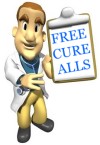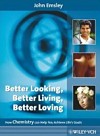 As I think I’ve mentioned before, I get a lot of emails from people claiming to have solved all the worlds environmental problems through some perpetual motion device or similar. These are not the usual run of the mill spam messages, they are usually targeted at me as a science journalist and talk of big solutions and the potential for a Time cover, a Pulitzer or some other grand prize. If they were sent by snailmail I suspect the majority would be written in lurid green ink.
As I think I’ve mentioned before, I get a lot of emails from people claiming to have solved all the worlds environmental problems through some perpetual motion device or similar. These are not the usual run of the mill spam messages, they are usually targeted at me as a science journalist and talk of big solutions and the potential for a Time cover, a Pulitzer or some other grand prize. If they were sent by snailmail I suspect the majority would be written in lurid green ink.
Some of these claims seem to reach global proportions as we’ve seen with the Steorn research, which is yet to bear fruit, although on July 4, Steorn announced it was planning to demo its results publicly; they are yet to materialise, in fact they were delayed to July 5, and at the time of writing had still not been shown.
For some of the more intriguing of these emails, I created a new section on SciScoop to cover and discuss just such controversial conjectures. I have also highlighted several odd scientific claims some time ago on Sciencebase too, purely for your amusement.
Anyway, those emails continue to arrive, within the last week or two I have had one claiming the amazing powers of an electrical device that seems to create energy from nothing. It strikes me and several energy scientists I spoke to as being nothing more than the electrical equivalent of Bhaskara’s wheel, although the inventor has every faith in his product. Good luck to him, I hope it works out.
I know several academics who are always more than willing to assist inventors with bizarre claims…for a fee. They delight in showing up the obvious flaws in an argument. I should send a pharmacology professor the most recent message I received, which claims to cure almost every form of cancer, despite cancer being simply an umbrella term for a massively diverse range of diseases. The email told of a very simple, small molecule, there is no targeting, and no clue as to a mode of action. I suspect the research runs along the lines of another unrelated compound that was popular on bad medicine sites about five years ago. I won’t name either compound for fear of giving them some kind of credence here or inspiring anyone to go looking.
Many of these emails claim that the invention precludes understanding, somehow lies beyond current scientific understanding, and often defies well-proven laws of nature.
Science and medicine do occasionally enter the realms of paradigm shifts, big changes to theory arise, but despite the popular perception these do not often, if ever, come in a single Eureka moment; even the eponymous event concerning Archimedes in his bath is almost certainly apocryphal and a brilliant piece of science popularisation. Moreover, no apple fell on Newton’s head, instead years of observations and the development of a new theory gave rise to his theory of gravitation. Likewise, although Einstein is credited with the theory of relativity, there were other theories around and he built his work on the solid experimental results from the latter half of the nineteenth and early twentieth century to gradually evolve Newton’s ideas at the cosmic scale.
It would perhaps be nice to imagine that there is a quickfix to our energy needs, a universal panacea for our ills, a maverick theory that explains life, the universe and everything, free cure-alls for everything, in fact. But, there isn’t. While, I occasionally draft a quick write-up for Sciencebase on the basis of some of the more plausible of those tantalizing emails with extravagant claims, more often, input from well-respected contacts in academia directs me, once again, to the overflowing Controversial Conjectures folder. Such emails are ultimately filed here for posterity. Whether or not the Steorn case turns out to be fit for this slot, we will have to wait patiently to see. As I said, their advertised demo is not yet available for display and their “offices” are closed for technical reasons. The latest word on the Steorn site is that overhead lighting caused device heating problems and Steorn has now decided to postpone the demonstration until further notice.
Anyone care to draw the obvious conclusion from that?
 Intute is the Science, Engineering and Technology component of a JISC project based out of England’s University of Manchester and the Heriot-Watt University in Scotland. It offers a free online service with what it describes as the very best web resources for scientific research and education. Like the very best of the earliest web portals all entries are hand selected and evaluated, so there is a serious lack of spam (thank goodness).
Intute is the Science, Engineering and Technology component of a JISC project based out of England’s University of Manchester and the Heriot-Watt University in Scotland. It offers a free online service with what it describes as the very best web resources for scientific research and education. Like the very best of the earliest web portals all entries are hand selected and evaluated, so there is a serious lack of spam (thank goodness). Hot on the heels of Monday’s cosmic search engine is news from Caltech that images of the oldest known galaxies have been obtained. These heavenly bodies existed at a time when the universe was a mere 500 million years old, some 13 billion years ago.
Hot on the heels of Monday’s cosmic search engine is news from Caltech that images of the oldest known galaxies have been obtained. These heavenly bodies existed at a time when the universe was a mere 500 million years old, some 13 billion years ago. I started a book on the chemistry of sex once…didn’t get very far, it was too distracting and working from home with my wife meant one thing led to another too often for us to knuckle down to the online research. TMI? Sorry.
I started a book on the chemistry of sex once…didn’t get very far, it was too distracting and working from home with my wife meant one thing led to another too often for us to knuckle down to the online research. TMI? Sorry. Want to know what time the moon will rise in your neck of the woods, which planet is in which constellation tonight, or when the Internation Space Station will next be overhead? There is not much stargazing going in England at the moment, too much H20 falling from the sky, but eZipSky’s free service for amateur astronomers in the US, is a kind of search engine for heavenly bodies.
Want to know what time the moon will rise in your neck of the woods, which planet is in which constellation tonight, or when the Internation Space Station will next be overhead? There is not much stargazing going in England at the moment, too much H20 falling from the sky, but eZipSky’s free service for amateur astronomers in the US, is a kind of search engine for heavenly bodies. As I think I’ve mentioned before, I get a lot of emails from people claiming to have solved all the worlds environmental problems through some perpetual motion device or similar. These are not the usual run of the mill spam messages, they are usually targeted at me as a science journalist and talk of big solutions and the potential for a Time cover, a Pulitzer or some other grand prize. If they were sent by snailmail I suspect the majority would be written in lurid green ink.
As I think I’ve mentioned before, I get a lot of emails from people claiming to have solved all the worlds environmental problems through some perpetual motion device or similar. These are not the usual run of the mill spam messages, they are usually targeted at me as a science journalist and talk of big solutions and the potential for a Time cover, a Pulitzer or some other grand prize. If they were sent by snailmail I suspect the majority would be written in lurid green ink. Doctor Who’s maverick side-kick Captain Jack, played by big show-tunes fan John Barrowman, took time out from his busy schedule to indulge a passion for mini big bangs with a visit to CERN, the world’s largest
Doctor Who’s maverick side-kick Captain Jack, played by big show-tunes fan John Barrowman, took time out from his busy schedule to indulge a passion for mini big bangs with a visit to CERN, the world’s largest An fMRI scan of the upper echelons of the human brain, reveals that there are apparently two commanders at the helm, according to US neuroscientists; it is as if Russell Crowe were joined by his twin brother to captain the ship. The work may suggest new insights into behavioural problems that occur following brain injury.
An fMRI scan of the upper echelons of the human brain, reveals that there are apparently two commanders at the helm, according to US neuroscientists; it is as if Russell Crowe were joined by his twin brother to captain the ship. The work may suggest new insights into behavioural problems that occur following brain injury.